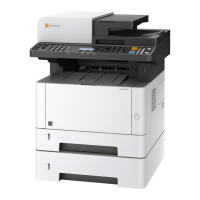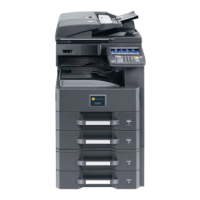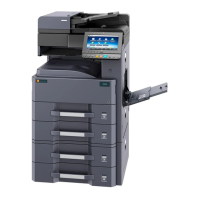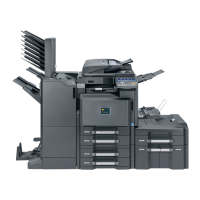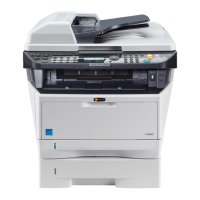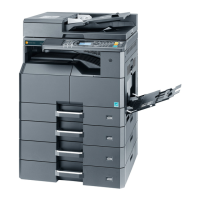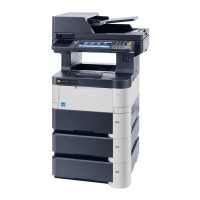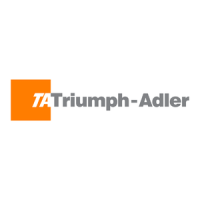
Do you have a question about the Triumph Adler 3555i and is the answer not in the manual?
| Category | All in One Printer |
|---|---|
| Type | Laser |
| Functions | Print, Copy, Scan, Fax |
| Print Technology | Laser |
| Print Speed (Black) | 35 ppm |
| Print Resolution | 1200 x 1200 dpi |
| Paper Capacity | 250 sheets |
| Connectivity | USB, Ethernet, Wi-Fi |
| Operating System Compatibility | Windows, macOS, Linux |
| Duplex Printing | Yes |
| Scan Resolution | 600 x 600 dpi |
| Copy Speed (Black) | 35 cpm |
| Copy Resolution | 600 x 600 dpi |
| Fax Transmission Speed | 33.6 kbps |
| Mobile Printing | AirPrint |
| Scan Type | Flatbed |
Understand the types of data the machine can process: Original, Electronic, Fax, USB.
Configure and utilize the machine's security levels according to your needs.
Expand the machine's functionality by installing applications for enhanced efficiency.
Explore the various output options: Copy, Print, USB Memory, Fax, Send.
Enhance workflow efficiency with features like one-touch programming and mixed-size scanning.
Implement energy-saving functions and store frequently used documents for efficiency.
Utilize functions to create booklets, print stamps, and adjust image appearance easily.
Secure your documents and data through PDF encryption, disk protection, and private printing.
Improve efficiency by displaying file size, using wireless networks, and utilizing USB memory.
Understand and select basic color modes like Auto, Full Color, Grayscale, Black & White, and Single Color.
Modify image quality for skin color, landscapes, and overall vividness using simple adjustments.
Information on the Quick Guide and Safety Guide provided in printed format.
Access to various guides in PDF format on the DVD, covering operation, fax, security, and more.
Understand the organization of the operation guide, detailing chapters and their contents.
Important information regarding safety conventions, environment, and precautions for use.
Essential guidelines for handling consumables and general operational precautions.
Safety information specific to laser radiation hazards in Europe, classifying the machine as Class 1.
Information on legal restrictions concerning copyrighted materials and specific items like paper money.
Details regarding copyright, trade names, and licensing information for software modules.
Information on Low Power Mode, Sleep Mode, and their automatic activation to save energy.
Details about the machine's compliance with ENERGY STAR® standards for energy efficiency.
Identification of the machine's exterior components and interior parts for installation and setup.
Instructions for connecting LAN, USB, and power cables to establish machine connectivity.
Guide on installing printer drivers and utilities from the provided DVD for Windows and Macintosh.
Procedures for logging into and out of the machine, including default credentials.
Configuration of essential machine settings like date, time, network, and energy saving functions.
Steps for setting up the machine's network connection using a LAN cable for TCP/IP and Bonjour.
Tasks for administrators, including strengthening security, sending documents to PC, and email scanning.
Accessing and configuring machine settings, security, and host names via a web browser.
Guide to operating the machine using the front panel keys and touch panel display.
Understanding the Home screen layout, icons, and taskbar for navigating machine functions.
Instructions on how to load paper into the standard cassettes, multi-purpose tray, and optional feeders.
Steps to prepare your computer by noting names and configuring shared folders and firewall settings.
Process for saving frequently used destinations like email addresses, folders, and fax numbers.
Follow steps to print documents from applications, including configuring print settings.
Instructions for setting up and executing banner printing for large-format documents.
How to print and delete documents stored in the Job Box, such as Private Print and Stored Jobs.
Guidance on placing originals on the platen or in the document processor for scanning or copying.
How to register, recall, edit, and delete frequently used function sets as programs.
Information on installing, activating, and deleting optional applications to expand machine functionality.
Procedures for canceling print or send jobs currently in progress or waiting.
Basic steps for performing copying operations, including selecting functions and quantities.
Guide to sending scanned documents via email, to folders, FTP, or custom boxes.
An overview of document box types (Custom Box, Job Box) and their functions for storing and managing documents.
Steps for creating, editing, storing, printing, sending, moving, copying, joining, and deleting documents in custom boxes.
Information on specific job boxes like Private Print/Stored Job, Quick Copy/Proof and Hold, Repeat Copy, and Form for Form Overlay.
Instructions for manually stapling finished documents using the optional finisher.
Overview of the various functions the machine offers, categorized for easy access.
How to specify the original size for scanning, including standard and custom size options.
Guide to selecting the appropriate paper source (cassette or multi-purpose tray) for printing.
Instructions for creating booklets by folding and stapling originals.
How to produce two-sided copies from one-sided or two-sided originals.
Adding custom text stamps to documents for identification or annotation.
Options for specifying image file formats (PDF, TIFF, JPEG, XPS) and adjusting image quality.
Restricting access to PDF files by assigning secure passwords for viewing, printing, and editing.
Monitor the status of jobs being processed or waiting, with different status screens available.
Review the history of completed jobs, including print, send, and store job logs.
Procedure to cancel any print or send job that is currently being processed or waiting.
Configure device connections and check their status, including removable memory and fax ports.
Check the current levels of toner, paper, and staples available in the machine.
Access and configure settings for overall machine operation, including system, network, and maintenance.
A comprehensive list of configurable settings within the System Menu, categorized by function.
Specify paper size and media type for cassettes and the multi-purpose tray.
Configure general machine operations such as language, default screen, sound, and function defaults.
Define settings for various media types, including paper weight and custom configurations.
Define how the machine should react to errors like paper jams, mismatches, or finishing issues.
Set default values for various functions like original orientation, image settings, and file formats.
Configure the Home screen display, including paper selection and auto image rotation.
Settings related to copying functions, such as paper selection, duplex, and reserve next priority.
Settings for sending functions, including destination, color type, and file format.
Configure settings for custom boxes, job boxes, and removable memory operations like storing and printing.
Settings related to printer functions, such as emulation, color settings, and paper feed modes.
Configure settings for printing various reports like status, network, and admin reports.
Configure machine system settings, including network protocols, security, and interface options.
Manage user access by setting up login administration, authentication methods, and security policies.
Set up job accounting to manage copy/print counts by account, track usage, and restrict access.
Initial setup steps for enabling job accounting, adding accounts, and logging in users.
Procedures for routine cleaning of machine parts to ensure optimal printing quality.
Guidelines for identifying and resolving common machine issues based on symptoms and checkpoints.
Procedures for responding to various messages displayed on the touch panel or computer.
Step-by-step instructions for removing paper jams from different locations within the machine and its options.
Overview of optional accessories available for the machine, such as feeders, finishers, and kits.
Information on optional applications that can be installed to enhance machine functionality.
Guide on how to enter characters using the on-display keyboard for names and settings.
Details on paper specifications, choosing appropriate paper, and handling special paper types.
Technical specifications for common functions, copy, printer, scanner, and optional equipment.
Definitions of technical terms and acronyms used throughout the manual.


